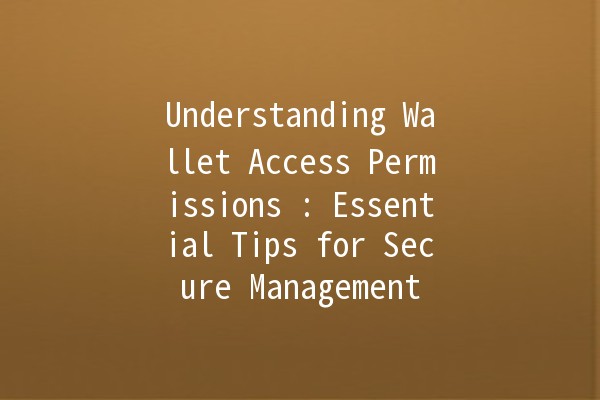
In today's digital age, managing access permissions for your digital wallets is more important than ever. With cryptocurrencies and various digital assets becoming mainstream, understanding how to properly manage wallet access is crucial for security and ease of use. This article provides practical tips to help you navigate wallet access permissions effectively, ensuring your digital assets are safe and easily accessible.
What Are Wallet Access Permissions?

Wallet access permissions define who can interact with your digital wallet and how. These permissions determine whether transactions can be made, assets can be viewed, or sensitive information can be accessed. Incorrect settings can lead to unauthorized access or loss of assets.
Why is Wallet Access Important?
Essential Tips to Enhance Your Wallet Access Permissions
Tip 1: Utilize MultiSignature Wallets
Explanation: A multisignature wallet requires multiple private keys to authorize a transaction. This means that even if one key is compromised, the wallet remains secure.
Practical Application:
Example: If you comanage a wallet with partners, each of you can hold a key. A transaction would need approvals from a majority, thus preventing any single party from making unauthorized transactions.
Tip 2: Set Up TwoFactor Authentication (2FA)
Explanation: 2FA adds an extra layer of security by requiring not just a password but also a secondary piece of information. This can be a code sent to your phone or an authentication app.
Practical Application:
Example: Enable 2FA on exchanges and wallet services that support it. This way, even if someone has your password, they cannot access your wallet without the second factor.
Tip 3: Regularly Review Access Permissions
Explanation: Periodically check and update who has access to your wallet. This is vital when personnel or partners change.
Practical Application:
Example: If a team member leaves the organization, revoke their access immediately. Implement a schedule (e.g., quarterly) to review active permissions and ensure only authorized individuals have access.
Tip 4: Educate Yourself and Your Team
Explanation: Knowledge is power when it comes to security. Understanding the nuances of wallet access permissions can prevent mishaps.
Practical Application:
Example: Conduct workshops or training sessions for your team on best practices for managing wallet permissions and recognizing potential phishing scams that could compromise access.
Tip 5: Use Hardware Wallets for Storage
Explanation: Hardware wallets store your private keys offline, which makes them less susceptible to online hacks compared to software wallets.
Practical Application:
Example: For longterm storage of significant amounts of cryptocurrency, use a hardware wallet like Ledger or Trezor. Both offer robust security features and are wellrespected in the cryptocurrency community.
Common FAQs about Wallet Access Permissions
Losing access can mean losing your assets permanently if you do not have a backup or recovery phrase. It's vital to keep these records secure and backed up in multiple locations.
Yes, sharing permissions increases the risk of unauthorized access. Only share access with individuals you trust and ensure they understand proper security practices.
Many wallets offer recovery options through backup phrases. Ensure you follow the recovery protocol and store your backup phrases securely.
Monitor transactions regularly for any unauthorized activity. Use security tools like wallet audits and ensure your software is uptodate.
Yes, there are several types: hot wallets (online) and cold wallets (offline). Each has different use cases and security implications.
A recovery phrase is a set of words that can restore your wallet if you lose access. Store it securely and never share it with anyone.
Strengthening Your Wallet Access Strategy
Managing wallet access permissions requires diligence and proactive measures. Utilizing tools like multisignature wallets, implementing 2FA, regularly reviewing access, educating your team, and using hardware wallets can significantly improve your security posture. Always stay informed about the latest security practices and be vigilant against potential threats.
By following these essential tips, you can ensure that your digital assets remain secure and that you maintain complete control over your wallet access permissions. With the right strategy, you can manage your digital wallet efficiently, keeping your assets safe from threats while enjoying the conveniences of digital transactions.

